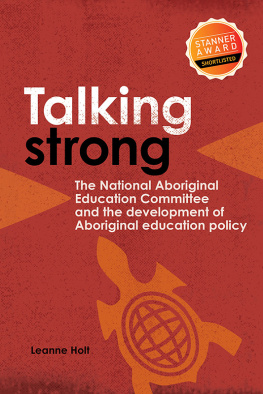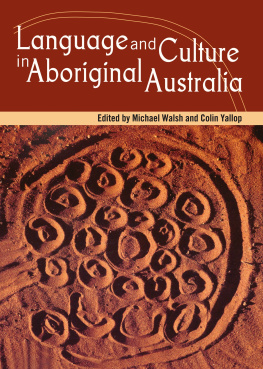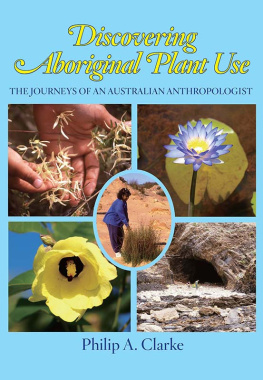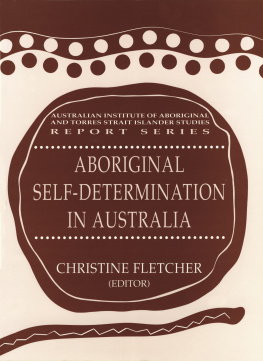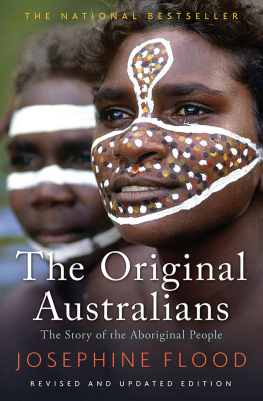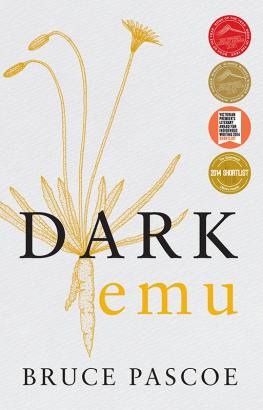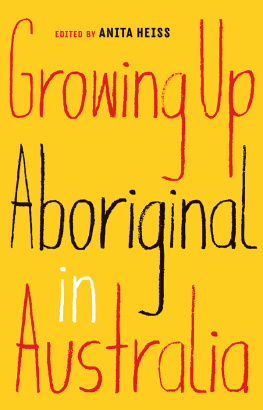Aboriginal Frontiers and
Boundaries in Australia
Aboriginal Frontiers and
Boundaries in Australia
S. L. Davis and J. R. V. Prescott
MELBOURNE UNIVERSITY PRESS
1992
First published 1992
Designed by Lauren Statham
Printed in Malaysia by
SRM Production Services Shd Bhd for
Melbourne University Press, Carlton, Victoria 3053
U.S.A. and Canada: International Specialized Book Services, Inc.,
5602 N.E. Hassalo Street, Portland, Oregon 97213-3640
United Kingdom and Europe: University College London Press,
Gower Street, London WOE 6BT, UK
This book is copyright. Apart from any fair dealing for the purposes of private study, research, criticism or review, as permitted under the Copyright Act, no part may be reproduced by any process without written permission. Enquiries should be made to the publisher
Stephen L. Davis and John Robert Victor Prescott 1992
National Library of Australia Cataloguing-in-Publication data
Davis, Stephen, 1951- .
Aboriginal frontiers and boundaries in Australia.
Bibliography.
Includes index.
ISBN 0 522 84483 9.
[1.] Aborigines, AustralianLand tenure. 2. Australia
Boundaries. 3. AustraliaHistoryTo 1788. I. Prescott,
J. R. V. (John Robert Victor), 1931- . II. Title.
333.2
This book is dedicated to all those senior custodians
who have maintained in their oral traditions the territorial
knowledge of their people.
Contents
Illustrations
Maps
1 The Territory of the Seri Indians
2 Named Localities on Balmawuy Sub-Territory
3 Boundary between Gamalangga and Balmawuy Territories
4 Area Held in Common by Munupula and Wilrangkuwila Clans
5 Aboriginal and Pastoral Interest in the Katherine and South Alligator River Area
6 Mineral Activity in the Alligator Rivers-Pine Creek Area
7 Land Claims in the Katherine and South Alligator River Area
8 Aboriginal Groups in the South Alligator River Area
9 The Lake Amadeus, Luritja Land Claim Area
10 Major Pastoral Stations and Settlements, Northern Territory, 18701896
11 Kuningga Native Cat Track
12 Watarrka Sub-Territory, Lake Amadeus, Luritja Land Claim
13 Lake Amadeus Land Claim Boundaries and Frontier
14 Torres Strait
15 Territories and Localities on Mabuiag Island
16 Territories and Localities in Western Torres Strait 1201
17 Boundaries of Regions and Zones Created by the Aboriginal and Torres Strait Islander Commission Act 1989
Figures
1 Seasonal Change and Resource Availability in Yolngu Territory
Tables
1 Aboriginal Land by Area in mid-1987
Preface
This book has been written to make two contributions. The first is to political geography. In the 95 years since RatzePs seminal Politische Geografie [Political Geography] was published the main contributions to the systematic study of political boundaries have been by geographers. This claim does not deny the brilliance of some lawyers such as Lapradelle or historians such as Lamb in their respective studies of boundaries and the law and the McMahon Line between China and India. But no other discipline has matched the comprehensive study of political boundaries provided by geography.
In Australia geographers, with occasional assistance from others, have extensively studied and written about the boundaries of States and Territories, local government authorities, electorates, maritime zones and claims to Antarctica. Boundaries related to the political organisation of Aborigines in contrast have attracted little attention from geographers or anthropologists. We hope that this book will remedy this neglect and round out the study of Australias boundaries by looking at the continents oldest political units.
Aboriginal boundaries are not only Australias oldest political limits; they also bid fair to become very controversial during the next decade. This decade has been designated a period of Aboriginal reconciliation by bipartisan agreement of the federal parliament. We believe that this process will result in increased demands for rights related to land by Aboriginal communities throughout Australia and expect that some of those demands will be treated sympathetically.
It is our hope that the dispassionate analysis in this book will contribute to the decade of reconciliation. That hope will be achieved if we can show that traditional Aboriginal boundaries were precisely defined in most of Australia, except in some remote, harsh deserts where frontiers existed, and that knowledge about those precise definitions still exists in some communities. Unfortunately every year the knowledge about the boundaries of some groups literally dies out.
The corollary of this statement is that over most of Australia, especially south of the Tropic of Capricorn, much of the precise knowledge about boundaries has been lost forever. It seems to us that where the knowledge is intact land claims should be decided on the basis of that knowledge when the proofs are provided. Where the knowledge about the precise extent of traditional territories has been lost mechanisms must be devised to make land grants or compensation without the charade of re-inventing knowledge or elaborating traditions that are imperfectly known or found in the records of anthropologists who did their work decades ago.
Acknowledgements
We are most pleased to acknowledge the efforts of the many people who have assisted in this work. In particular we wish to mention Nahassan Ungkwanaka (deceased, Matutjara tribe), Helmut Parerultja (deceased, Western Arranda), Eric Panangka (Anmatjerre), Felix Holmes (Limilngan), Raphael Apuatimi (deceased, Tiwi), Old Elsey (deceased, Yangman), Buthugurrulil (deceased, Gamalangga), Liyadarri (Gupapuyngu), Niburrurru (deceased, Mudburra), Mamakun (Birrkili), Makani (deceased, Mildjingi), Cliff McCormack (deceased, Tiwi), Yithirri (Gupapuyngu), Danyala (Liyagawumirr), John Baptist (Tiwi), Mick Wagu (Ngalia), Gideon Jack (Pintubi), Demaga Warria (Maluigal), Kami Pai Pai (Maluigal), Gib Gaulai (Maluigal), Sandy Barraway (Jawoyn), Andy Andrews (Jawoyn), Peter Jatpula (Jawoyn) and Nipper Brown (Jawoyn). Gary Stoll (Fink River Mission) has one of the most profound outsiders understandings of Aboriginal culture in Central Australia and gave freely of his knowledge. Michael Maurice, Q.C. whilst Aboriginal Land Commissioner afforded us access to much of the archives of the Northern Territory land rights cases. The manuscript has been typed and refined through the very efficient word processing of Catherine Haensel whilst Eric Ireland has skilfully interpreted our every requirement in constructing the maps.
Finally, funding for a significant part of the research on which this book is based was generously provided by the Australian Mining Industry Council without whose assistance this information may not have reached the public domain.
Territorial Limits of
Aboriginal Peoples
With the exception of a motion passed by the national convention of the Young Liberals in early 1991 political parties in Australia generally see merit in the concept of land rights for Aborigines. The Young Liberals were persuaded that Aborigines in 1788 had no concept of private ownership, did not attempt to convert the land into private property through development, exploitation or settlement and so no property was taken from them or their descendants. This view was rejected by the parliamentary Liberal Party.




